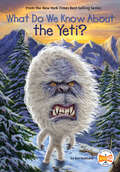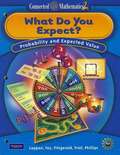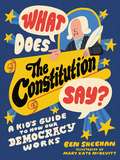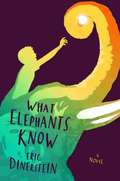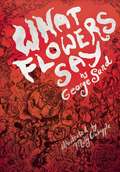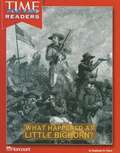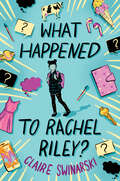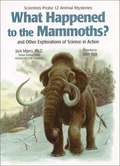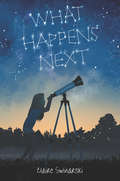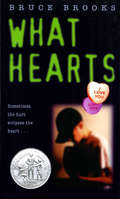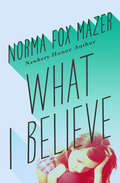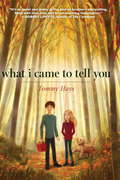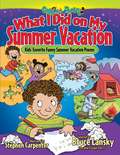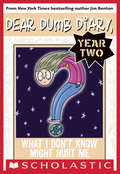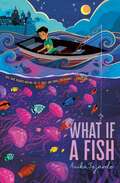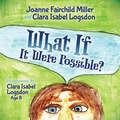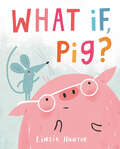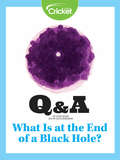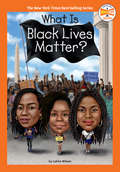- Table View
- List View
What Do We Know About the Yeti? (What Do We Know About?)
by Ben Hubbard Who HQThe What Do We Know About? series explores the mysterious, the unknown, and the unexplained. Does the ape-like Yeti really roam the Himalayan mountain range?Not quite human and not quite an animal, the Yeti has been the subject of speculation for centuries. In modern times, the Yeti has become a popular cryptid, appearing in movies, books, and TV shows. Although there are many claimed sightings of the Yeti, there is no real evidence that it exists. This elusive cryptid, also known as the Abominable Snowman, remains a mystery. Does the Yeti truly live in the snowy Himalayas? Have the Sherpa who live there spotted him at the highest altitudes? Here are the facts about what we really know about Yeti sightings, research, and lore.
What Do You Expect: Probability and Expected Value (Texas)
by Glenda Lappan James T. Fey William M. Fitzgerald Susan N. Friel Elizabeth Difanis Phillips WestWords Inc.NIMAC-sourced textbook
What Do You Expect?, Probability and Expected Value
by Glenda Lappan James T. Fey William M. Fitzgerald Susan N. Friel Elizabeth Difanis PhillipsNIMAC-sourced textbook
What Do You Know About the Water Cycle? (20 Questions: Earth Science)
by Gillian GosmanThe 20 questions in this volume give kids a thorough tour through the water cycle. The questions and their answers also explain related topics such as the difference between freshwater and saltwater, and the causes and effects of water pollution. This is a wonderful resource for reports and for building a vocabulary of scientific terms.
What Does the Constitution Say?: A Kid's Guide to How Our Democracy Works
by Ben SheehanIf you've never read the Constitution, let this guidebook help you! Featuring fun facts, cool illustrations, and even hilarious jokes, What Does the Constitution Say? will help you understand how our American government really works. Written more than 230 years ago, the Constitution can be hard to understand (even for adults). But it also gives you what you need to make our country the best it can be for everyone. What Does the Constitution Say? takes you on a tour of the whole Constitution while explaining what its fancy words really mean. From the Preamble to the 7 Articles to the 27 Amendments (so far), this fun-to-read guide is packed with bite-sized info, historic quotes, and graphics on important topics such as:Why the Constitution is a "living document"How the first attempt at a constitution (the Articles of Confederation) failedWhat powers the president does (and doesn't) haveKey figures like James Madison, Alexander Hamilton, and George WashingtonA bonus section on the Declaration of IndependenceAnd much more!
What Elephants Know (What Elephants Know Ser.)
by Eric DinersteinAbandoned in the jungle of the Nepalese Borderlands, two-year-old Nandu is found living under the protective watch of a pack of wild dogs. From his mysterious beginnings, fate delivers him to the King's elephant stable, where he is raised by unlikely parents-the wise head of the stable, Subba-sahib, and Devi Kali, a fierce and affectionate female elephant. When the king's government threatens to close the stable, Nandu, now twelve, searches for a way to save his family and community. A risky plan could be the answer. But to succeed, they'll need a great tusker. The future is in Nandu's hands as he sets out to find a bull elephant and bring him back to the Borderlands. In simple poetic prose, author Eric Dinerstein brings to life Nepal's breathtaking jungle wildlife and rural culture, as seen through the eyes of a young outcast, struggling to find his place in the world.
What Flowers Say
by Holly Erskine Hirko George Sand Molly CrabappleRoses plead to go out to dance; an old oak tree offers advice; paintings of gods and goddesses come alive. In What Flowers Say, renowned writer George Sand dares children to fantasize, to believe in an alternate world. This magical collection, originally penned for her grandchildren, calls into question what is real, a life lesson from someone who refused to accept the gender roles available to women in the nineteenth century. Sand shares her love and immense knowledge of science and mythology, engages issues of class and character, and captures the wonder and determination of a curious child, offering all of us a true sense of infinite possibilities--well beyond the world we live in.George Sand (1804-76) is considered the first professional woman writer of fiction. She wrote many novels, including Indiana and Léila, plays, newspaper articles, and a memoir, Story of My Life. The movie Impromptu is based on her life.Molly Crabapple is a painter, illustrator, and writer based in New York. She has written many books, including Discordia and Week in Hell, and produced work on subjects including the Spanish general strike, her former career as a pinup model, her arrest during Occupy Wall Street, and her visit to Guantanamo Bay. Her illustrated memoir, Drawing Blood, is forthcoming in 2015.
What Goes Around (Fountas & Pinnell Classroom, Guided Reading)
by Mark Shulman Shane JohnsonNIMAC-sourced textbook
What Goes Up
by Wen Jane BaragreyWhat goes up . . . comes down on Robyn Tinkerbell Goodfellow's roof! Will a rogue NASA satellite crush her house before Robyn can set things right?Robyn Tinkerbell Goodfellow (yes, that's actually her name) has a target on her roof. Well, not a real one, but everything seems to land there: paper airplanes, lost kites, socks, cats, and once even a skydiver! In the town of Calliope, Robyn and her magnet roof are famous--for being weird. That wasn't such a big deal . . . until now! A rogue NASA satellite is falling out of orbit and is going to hit Earth. NASA says it will probably land in the ocean, but Robyn knows better--that satellite is headed for her roof. To make matters worse, Robyn discovers that she doesn't just have a fairy middle name. When her class reads A Midsummer Night's Dream, she learns that Robin Goodfellow is a fairy! Which means if the satellite flattens her, everyone will laugh at her name in the news stories. Robyn realizes what she needs to do: find her long-lost dad so he can help her change her name and protect her from the satellite! Both surprising and relatable, this middle-grade novel will have readers wishing they could move to the small town of Calliope, laugh with the larger-than-life characters, and race against the clock to save Robyn from NASA's mistake.
What Happened At Little Bighorn?
by Stephanie St. PierreThere were many more battles between the Army and the Native Americans, especially the Lakota. The last battle of the Indian wars took place at Wounded Knee on December 29, 1890. By 1900 the life on the open plains that the Lakota, Cheyenne, and other Indians had known and loved was over.
What Happened to Rachel Riley?
by Claire SwinarskiIn this engrossing and inventive contemporary middle grade novel that's Where'd You Go Bernadette? with a #MeToo message, an eighth grader uses social media posts, passed notes, and other clues to find out why a formerly popular girl is now the pariah of her new school. <p><p>Anna Hunt may be the new girl at East Middle School, but she can already tell there’s something off about her eighth-grade class. Rachel Riley, who just last year was one of the most popular girls in school, has become a social outcast. But no one, including Rachel Riley herself, will tell Anna why. <p><p>As a die-hard podcast enthusiast, Anna knows there’s always more to a story than meets the eye. So she decides to put her fact-seeking skills to the test and create her own podcast around the question that won’t stop running through her head: What happened to Rachel Riley? <p><p>With the entire eighth grade working against her, Anna dives headfirst into the evidence. Clue after clue, the mystery widens, painting an even more complex story than Anna could have anticipated. But there’s one thing she’s certain of: If you’re going to ask a complicated question, you better be prepared for the fallout that may come with the answer.
What Happened to the Mammoths?: And Other Explorations of Science in Action
by Jack MyersIntriguing questions about animals are answered by scientists in these twelve explorations taken from the award-winning column in Highlights for Children magazine.
What Happens Next
by Claire SwinarskiIn this heartfelt and accessible middle grade novel perfect for fans of The Thing About Jellyfish, a young girl throws herself into solving a local mystery to keep from missing her older sister, who has been sent to an eating disorder treatment facility. <P><P>Astronomy-obsessed Abby McCourt should be thrilled about the solar eclipse her small town of Moose Junction is about to witness, but she’s not. After her older sister Blair was sent away for an eating disorder, Abby has been in a funk. <P><P>Desperate to dull the pain her sister’s absence has left, she teams up with a visiting astronomer to help track down his long-lost telescope. Though this is supposed to take Abby’s mind off the distance between her and Blair, what she finds may bring her closer to her sister than she ever thought possible.
What Hearts
by Bruce BrooksFour interrelated stories focus on Asa's keen intelligence and ability for forgiveness in the face of his mother's emotional instability and his own unsettled life. <P><P> After his mother divorces his father and remarries, Asa's sharp intellect and capacity for forgiveness help him deal with the instabilities of his new world.<P> Newbery Honor book
What I Believe
by Norma Fox MazerVicki wishes she could solve her problems as easily as she can arrange words into a poem Vicki Marnet has two wonderful big brothers who are completely regular people. They like sports, chess, and the student senate, and are totally normal--unlike Vicky, who feels in her heart that she's different. For one thing, she writes poetry for fun. She plays with sonnets, pantoums, sestinas--all kinds of stanzas and rhymes, anything to take her mind off what's happening at home. Vicki's dad lost his job, and since he can't find another one, her family is moving to the city. They're selling their big house, moving into a tiny apartment, and facing troubles that Vicki has never known before. Ashamed and slow to make friends at her new school, Vicki puts her thoughts down in verse as she makes a new place for herself--one that's very much her very own.
What I Came to Tell You
by Tommy HaysSince his mother died earlier this year, Grover Johnston (named after a character in Thomas Wolfe's Look Homeward Angel) has watched his family fall to pieces as his father throws himself into his work rather than dealing with the pain. Left to care for his younger sister, Sudie, Grover finds solace in creating intricate weavings out of the natural materials found in the bamboo forest behind his North Carolina home, a pursuit that his father sees only as a waste of time.But as tensions mount between father and son, two unlikely forces conspire to lead the Johnstons on a new path -- a presence that seems to come to Grover in his darkest moments and new tenants in the rental house across the street who have come from deep in the Carolina hills and plopped themselves right into Grover's life. The families seem so different but become increasingly intertwined, bound together in unexpected ways. Until one devastating disaster threatens to tear them apart.Tender, touching, and utterly compelling, What I Came to Tell You, the first middle-grade novel from critically acclaimed Asheville author Tommy Hays, is a story of grief, love, and hard-won redemption.A 2013 Fall Okra Pick, Southern Independent Booksellers Alliance * "Hays is a gifted storyteller, offering up an effective balance of credible emotion, understated wisdom, and gentle humor."--The Bulletin of the Center for Children's Books, starred review * "Hays is especially strong at depicting the network of people, old and young, who help Grover and his family move through their grief and, along the way, save his beloved forest."--Publishers Weekly, starred review "Hays' story is filled with touching honesty and youthful wisdom, all of which help undergird Grover's own discovery of the healing power of family, love, and art." --Booklist "Readers will be quickly and surely drawn in by quirky siblings Grover and Sudie, rooting for them to find a measure of peace and happiness in the wake of tragedy."--Kirkus Reviews "Set in Asheville, North Carolina, the story has a pleasing Southern flavor." --School Library Journal "Throw in some local politics, prejudice, budding romances, family tugs-of-war and an odd man who seems to linger everywhere, and you have a penetrating and complex story of loss and, ultimately, the rebuilding of a family. Tommy Hays' first middle grade novel, What I Came to Tell You is a thoughtful, tender look at a family devastated by grief."--BookPage Releases simultaneously in electronic book format (ISBN 978-1-60684-434-2
What I Did on My Summer Vacation: Kids' Favorite Funny Summer Vacation Poems (Giggle Poetry)
by Bruce LanskySummer days are here again!Here are over forty sidesplitting poems about summer vacation, covering everything from the much-anticipated last day of school to family road trips, wacky days at summer camp, learning how to swim, dizzying roller coaster rides, fun-filled days at the beach, and finally, the dreaded first day of the new school year. These hilarious poems written by Bruce Lansky, Kenn Nesbitt, Robert Pottle, Eric Ode, and Neal Levin, and the rest of the all-star gang of Giggle Poets are sure to make you count the days until summer vacation begins!Beach Book Festival Award (Honorable Mention Finalist: Children's Books), USA Book News (Best Books Award Finalist), Moonbeam Children's Book Awards (Children's Poetry Gold Award).
What I Don't Know Might Hurt Me (Dear Dumb Diary Year Two #4)
by Jim BentonBestselling author Jim Benton is back, continuing a new spin on a favorite series!Dear Dumb Diary, Just when I was pretty sure we could let the Student Awareness Committee quietly die a dignified death like some majestic old elephant or the Square Dancing Club, Angeline has to be aware of something. Great.And, of course, it couldn't be something interesting like nail polish or why maybe there should be a special class in nail polish and how to get it out of your beagle's ear. (Mom, if you're reading this, I'm not admitting anything. Somebody else could have painted a heart in his ear.)Angeline just had to be aware of one of those THINGS THAT ADULTS LIKE.
What If a Fish
by Anika FajardoA whimsical and unflinchingly honest generational story of family and identity where hats turn into leeches, ghosts blow kisses from lemon trees, and the things you find at the end of your fishing line might not be a fish at all. <P><P>Half-Colombian Eddie Aguado has never really felt Colombian. Especially after Papa died. And since Mama keeps her memories of Papa locked up where Eddie can&’t get to them, he only has Papa’s third-place fishing tournament medal to remember him by. He’ll have to figure out how to be more Colombian on his own. <P><P>As if by magic, the perfect opportunity arises. Eddie—who’s never left Minnesota—is invited to spend the summer in Colombia with his older half-brother. But as his adventure unfolds, he feels more and more like a fish out of water. Figuring out how to be a true colombiano might be more difficult than he thought.
What If Humans Were Like Animals?
by Marianne TaylorEveryone has wondered what it would be like to be their pet dog or cat--covered in fur, walking on all fours. But have you ever wondered what it would be like to have eight eyes and legs like a spider? What if you drank through a straw that was part of your mouth like a butterfly? The imagination runs wild in this book that explores the hilarious possibilities of what it would be like if people had the traits of animals all while learning distinct and disgusting facts about these animals. For instance, picture what it would be like if people . . . . . . carried their young in their mouths like jawfish do. . . . were as strong as carpenter ants, which can lift 850x their own weight. . . . could stretch over 10x their own length the way that ribbon worms can. . . . had eyes in their hands like starfish. . . . had skunk defenses and squirted some stink out of their rears when they're attacked.What If Humans Were Animals imagines all these possibilities and more in hilariously graphic picture and gag-provoking text that entertains as well as educates. Readers will never be able to forget all these animal facts when they picture them in this zany and outrageous context.
What If It Were Possible?
by Joanne Fairchild Miller Clara Isabel LogsdonThe author and her eight-year-old granddaughter, Clara, explore the world of their imaginations in this unique children&’s book illustrated by Clara. What if it were possible . . . for a dog to climb a tree? What if it were possible to climb like you and me? What if pretty butterflies could spread their wings and swim? And elephants could wear their trunks while working out at gyms? Anything can happen if you think it might. In your imagination, ANYTHING is RIGHT! Eight-year-old Clara has a vivid imagination. One day while visiting her Yia-Yia, author Joanne Miller, they watched Clara&’s dog, Harley, desperately try to climb a tree to get a squirrel. Then Joanne asked Clara a provocative question: &“What if it were possible for a dog to climb a tree?&” And the rest is history. Joanne and Clara had lots of giggles coming up with crazy lines for this book, and Clara drew each illustration with water color pencils. Clara and her Yia Yia don&’t believe play and imagination are only for children. In What If It Were Possible? they demonstrate the limitless wonders we can discover in our minds.
What If, Pig?
by Linzie HunterYou’re not going to find a more heartwarming dynamic duo than Pig and Mouse! Join Pig as he learns how to turn his “what if" worries from anxiety to optimism, all with the help of his loving friend Mouse."Readers will certainly empathize with Pig and his emotions." —Kirkus “Hunter’s picture book will draw its audience with vibrant colors, oh-so-adorable characters, and plenty of silliness” –Bulletin of the Center for Children’s Books"Young readers will learn that being afraid is a common, temporary feeling, and that they can talk to others about it." —School Library Journal Mouse has never had a friend quite like Pig. Pig is so incredibly kind, fabulously fun, but he also has a big secret—he’s a tremendous worrier!When Pig gets the brilliant idea to throw a party for Mouse and their friends, he can’t help but think of everything that could possibly go wrong. After all, what if a lion eats all the invitations? What if nobody comes? Or worse, what if everyone comes and has an awful time?In this adorable story, Linzie Hunter’s charming, bright illustrations pair perfectly with her sweet and funny story about friendship and the endless wonder of "what if" that readers of all ages can relate to. This picture book is a great conversation starter in the home or classroom.
What Is a Solar Eclipse? (Who HQ Now)
by Dana Meachen Rau Who HQLearn about the phenomenon of a solar eclipse just in time for the Great American Eclipse that will take place on April 8, 2024 in this title in the Who HQ Now series featuring newsmakers and trending topics.Just in time for the third North American total solar eclipse of the twenty-first century, this book explains how to safely observe solar eclipses, how long eclipses last, and why they result in a blackout period during the day. Young armchair astronomers and astronauts will be inspired by the wonders of outer space and what exists beyond our atmosphere as they learn more about the moon, the sun, and our earth. What really happens during a solar eclipse and how does it affect the energy in our atmosphere? You'll find the most up-to-date eclipse information in this exciting new book.
What Is at the End of a Black Hole?
by Lizzie WadeWho knows what is at the end of a black hole? Astrophysicists!
What Is Black Lives Matter? (Who HQ Now)
by Lakita Wilson Who HQFrom the #1 New York Times bestselling series comes the latest title in the Who HQ Now format for trending topics. It tells the history of a political and social movement that advocates for non-violent civil disobedience and protests against incidents of police brutality--and all racially motivated violence--against Black people.When a Black teenager named Trayvon Martin was senselessly killed in 2012, the African American community called for his murderer to be held accountable. But like many other racially sparked incidents in the past, his killer walked free. People looked for justice and healing in the moment. They turned to social media and a simple yet powerful hashtag emerged, #BlackLivesMatter. The message grew into an international movement and has now become the rallying cry during protests against police brutality and racial acts of violence. The movement gained even more attention and support in 2020 when it called for police reform in the United States after the police-related murder of George Floyd.
